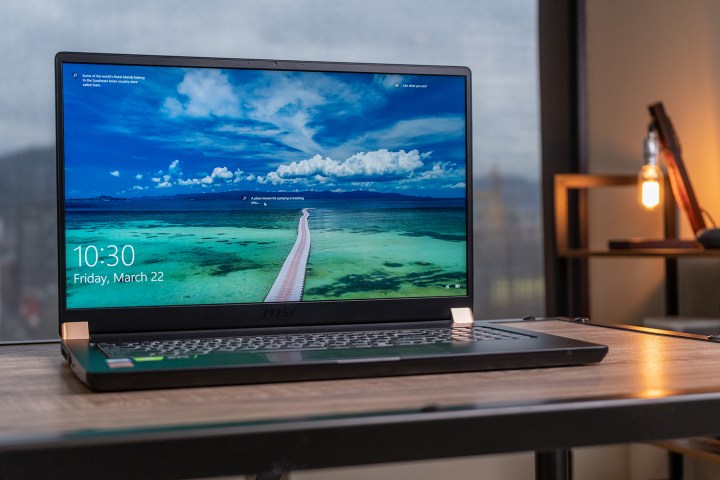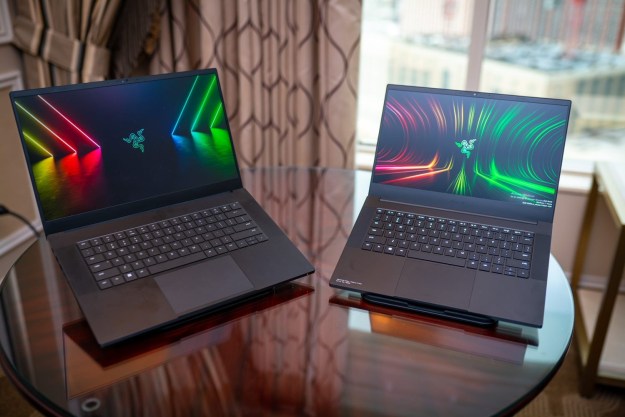
Small laptops are great for portability, but if you want a premium gaming notebook experience, you need to opt for something a little larger. The Razer Blade Pro and the MSI GS75 Stealth are two of the best gaming laptops we’ve tested in recent years and most gamers would be lucky to have either to hand for their next game, but which is better?
Although that may come down to your particular preferences, with a focus on specific features and specifications, we feel confident we can sort out the debate of the Razer Blade Pro versus the MSI GS75 Stealth.
Design

The Razer Blade Pro is the first refresh of Razer’s 17-inch gaming laptop in a couple of years and this brings it in line with some of the more incremental updates that Razer has made to its more mainstream
It’s not a unique looking laptop by any means, but it is clean and practical with nice keyboard backlighting and a slightly slimmer design from what came before. Its all-aluminum chassis feels strong and well built, and we particularly liked the new vapor chamber cooling with additional vents near the hinge to make for a less-toasty laptop gaming experience.
The MSI GS75 Stealth, on the other hand, stands out more despite its demure aesthetic. It has a slightly flimsy build-quality which is a shame, because the overall design is one we quite enjoyed. It ditches the lights and frills of some
One problem with the GS75 is the touchpad. While the Razer Blade Pro has a large, accurate, and tactile touchpad, the GS75’s is strangely misplaced. Because the keyboard is shifted over to fit it in a numberpad, you’ll find the touchpad directly under your palms while typing. While the touchpad itself is fine, it’ll definitely cause some mis-clicks here and there.
Port-wise, you have a little bit of everything with the GS75 Stealth. It has a USB-C 3.2 Gen 2 that’s fully
Performance

What’s a gaming laptop without heaps of gaming power behind it? The Razer Blade Pro is decidedly that, with a six-core, 9th-generation Intel Core i9-9750H CPU. That processor can hit 4.5GHz when boosted and it comes with up to 64GB of memory and between 512GB and 4TB of PCIe SSD storage. Graphics card options include a full-fat Nvidia RTX 2060, as well as Max-Q designs for the RTX 2070 and RTX 2080.
The Razer Blade Pro sells for $2,500 with the RTX 2060, or as much as $3,200 with the RTX 2080.
The MSI GS75 Stealth’s base configuration starts at a cheaper $1,780 and sports a last-generation processor. It’s far from incapable, though. The Core i7-8750H is a fantastic gaming CPU with six cores, 12 threads, and a boost core clock of 4.1GHz. Buyers can choose up to 32GB of memory (which is how much ram you need), up to a terabyte of PCIe NVMe storage, and one of three same options for graphics chips. There are also a few configurations on some sites selling a model with a Core i9-9980H CPU, which offers an additional two cores and a higher clock speed of 4.8GHz. Though we haven’t tested it yet, this Core i9 would push performance above the Razer Blade Pro — that is, as long as the cooling system could handle the extra heat.
The highest-end configuration of the GS75 costs up to $3,399 — even higher than the Razer Blade Pro. Our review unit with the mid-tier CPU but the top-end graphics option delivered fantastic frame rates in Fortnite, Battlefield V, and Assassin’s Creed: Odyssey, with playable frame rates at the highest detail settings at even
Neither system offers anything different in the way of display options. They both have a 17.3-inch 1080p IPS panel with a high-refresh rate of 144Hz. With their port-selection, however, both systems can output to
Portability

No one is pretending that either of these
The Razer Blade Pro weighs just over six pounds and is less than 0.79 inches wide at its thinnest point. Its full dimensions are 15.55 x 10.24 x 0.78-inches. The MSI GS75 Stealth is more than a full pound lighter, at 4.96-pounds and measures 15.59 x 10.2 x 0.75 inches, so is the slightly trimmer device overall.
We haven’t had a chance to test the Blade Pro’s battery just yet, but its 70.5 watt-hours should give it around five hours during light usage, though likely less in heavier gaming sessions. The GS75’s battery is greater with 82 watt-hours. It managed nearly seven hours of video playback in our testing, and nearly six hours in our web browsing benchmark. That’s comparable to some of the
MSI sneaks into the lead… for now
This is a close fight, but we can’t give the Razer Blade Pro a full recommendation over the MSI GS75 until we get it in for a full review. Our short preview time with the device left us impressed, but we still have to wonder about performance. As of now, the MSI GS75 Stealth is our favorite 17-inch
They both have great port selections, decent high-speed screens, and cool and quiet thermal management systems, but the MSI GS75 is an all round better package. That is, when we tested it, which is something we haven’t been able to do with the Razer Blade Pro yet. When that happens, we’ll have to reevaluate.
These are both solid 17-inch
Editors' Recommendations
- The Razer Blade is losing its edge
- CES 2023: Razer teases Blade 16 and Blade 18, a return to large gaming laptops
- This Razer Blade firmware update could improve GPU performance
- Powerful new Razer Blade laptops officially get a price hike
- As gaming laptops rise in price, Razer discontinues its cheapest Blade 15 model




